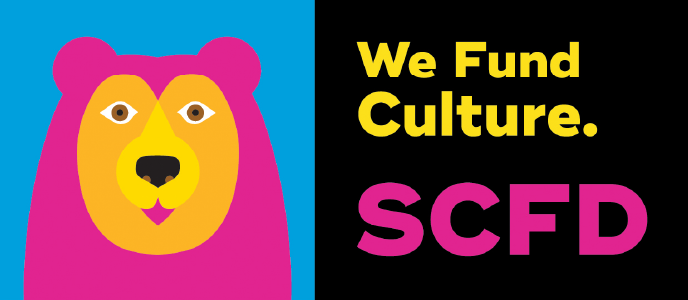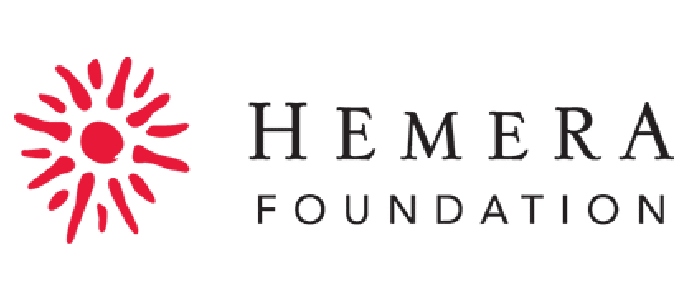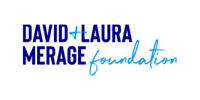An artist interview of Clay Hawkley by Along the Line blog writer Beth Hoyes
I find Clay Hawkley, originally from Idaho, in his studio at the RedLine Contemporary Art Center. He sits opposite me on a foldable metal chair. At one point he takes the chair from under him, activates a kickstand he’s attached to the side of it and props it up at an angle creating a spontaneous sculpture. I am delighted at how quickly he sets it up, like he’s done it a thousand times. This was in response to me asking whether there is a pivotal artwork he’d made that stood out for him. The impromptu chair sculpture started as a random observation, where Clay saw some bikes left lying on the ground with unused kickstands, inspiring him to add a kickstand to the chair that he took from outside his studio in Boulder. At many points as we talk about his process, we connect the dots back to things that Clay finds or that catch his attention whilst out and about. As he shows me the chair he says this piece is one of his favorites, representing the themes he most loves about his art making process, it’s spontaneous, playful and explores ideas of functionality and essentially seeing an everyday item or observation in a totally new way. Clay is all about accessibility and adding new life or perspectives to everyday objects and experiences, expanding on these to explore the hidden depths and implications of things that are often overlooked alongside seeing the familiarity and simplicity in them. I talk about how maybe when the objects are transformed through his art making process, they are seen on a higher level somehow or given added meaning. Clay disagrees, seeing it more as sideways, or a progression, opening up new possibilities or alternatives, giving the object a chance at being seen in a different way. Clay goes on to talk about his love of experimenting and how he gains inspiration from things he sees day to day.
A Sculpture and A Chair (2016) kickstand and chair; 36 x 33 x 36 inches
An overarching project Clay’s been working on where he uses photographic portraits of suspected shoplifters started with seeing a printed photograph of an alleged shop keeper tacked up near the cash register. After asking the shop owner about it, Clay was given a large file of photos to look through in a thick black file titled ‘86’ in large lettering. The file contains several photos of kids mainly, who are suspected of shoplifting, which were posted over time as a way of ‘naming and shaming’. As I look through the file, I see that many of the faces are doodled on and defaced; one even has ‘probably tortures cats’ scrawled on the bottom. Clay and I speak about the ‘call out’ culture and the potential abuse of photographs or identity through the process of stereotyping, labeling and shaming. Through his art making process Clay has taken these photographs and added layers to them in a way akin to a camouflage pattern, nodding to the militaristic aspects of surveillance. In my view on seeing Clay’s artwork that stems from the original photos, there is a kindness to re-camouflaging the faces caught on camera, giving the images a softer, more blurred effect where faces are allowed to become anonymous again rather than singled out, although there is still an unnerving sense of being watched. Clay mentions the friction between presenting something real and honest, whilst also recognizing the difficulty of photographs being misrepresentative of actual individuals. Surveillance and handing over the power of identification to machines is a central theme in his current art making investigations where he is exploring how computers misidentify objects such as mistaking cars for paper clips. We also talk about how current facial recognition technologies are more likely to misidentify faces when it comes to people of color. This obviously has huge implications in relation to power, racism, profiling and other invasive technologies. Since being based at RedLine, Clay’s work increasingly instigates discourses around social justice and he believes in his artwork prompting shifts in peoples’ views or ways of looking at things, however small or big. Clay’s wish for his artwork is for it to have a ripple effect, challenging conventional views of power, masculinity and social issues and for viewers to take in something new or explore a fresh viewpoint. A key theme for Clay is the misuse of power; questioning power structures and masculinity in relation to disrupting the idea of an ‘ideal man’ being limited to strength and fitness.
Work in progress. Part of a series, “86: exclusion, surveillance and class.”
“Clay’s wish for his artwork is for it to have a ripple effect, challenging conventional views of power, masculinity and social issues and for viewers to take in something new or explore a fresh viewpoint. ”
Another artwork that started as something Clay spotted whilst out and about on vacation in Washington State was a large sign saying ‘No’. This artwork grew roots in spotting three signs outside someone’s house saying, ‘No’, ‘No’, ‘No’. Clay decided to make his own sign to explore responses. When he eventually had a chance to ask about the reason for the original signs, he was told that the person who lived in that house just didn’t want people to take from their wood pile. This element of the viewer working out their own meaning to a piece without knowing the full story of how the object or artwork came to be is an important element of Clay’s work. He enjoys leading the viewer some or most of the way, leaving a part unresolved so that they can fill in the gaps as part of their own relationship to it, as Clay puts it ‘to spark new interpretations’. Clay displayed his ‘No’ sign as part of his ‘Hitch Gallery’, a way of showing his artwork and installations on the back of his car in public. One day Clay came out to see a kid sitting on one of his installations and was excited that people were interacting with it.
Portrait of the artist Clay Hawkley in his studio at RedLine
In each of Clay’s artworks you can follow the thread back to roots in the real or original object or image, meaning although it is given new meaning or has changed somehow it is still familiar, and recognizable. Perhaps the most central element that inspires Clay’s work is found objects. When I ask what it is about “found objects” that speaks to Clay, he says it is the familiarity, mystery, and the potential for them to have another existence. His fondness for found objects also links to one of his favorite guilty pleasures of watching the Antiques Roadshow series, where people bring found or cherished items to learn about their history, function, or worth. His face lights up as he talks about the everyday things or items that people treasure and his fascination with the objects being filled with transformative new meaning and history over the space of 2-3 minutes. When we speak about Clay’s processes of transforming found objects into artwork, I am reminded of a sense of the forgotten or over-seen objects regaining significance somehow, so that they become a sort of talisman. Whilst talking about Clay’s recent reading of A Peoples’ History of the United States (Zinn, 1980) he expresses his love for learning about everyday experiences and for stories to come from the ‘bottom up’ rather than from the ‘top down’ in society, finding a voice for people who were and are living ordinary lives surrounded with objects and experiences.
An artwork that stands out for Clay as we talk about inspirations that come to mind is Duchamp’s Door (Duchamp, 1927) where a door is hung on two frames in the corner of a room, meaning that the door is both opened and closed at the same time. Clay describes his love for artwork that challenges viewers through a concept or idea. We explore seeing this artwork philosophically as a door that is closed to some and open to others, relating it to the current climate around political divisions, privilege, or borders. Clay also brings it back to the possibility of seeing it in a home magazine as a unique solution for a space with two doorways. The potential to see the real or the philosophical in Clay’s work is always there, but he leaves the direction you go up to you. Which brings me back to Clay’s chair sculpture both being functional as he sits during the interview and suddenly transforming into an artwork as its propped up at an angle. In this multifaceted way, Clay plays with the idea of what art is and how much depends on the viewer’s perception, worldviews, and curiosity. When I say the word ‘guerilla’ as a way to describe some of Clay’s process, he feels that this is a good way to define it, in the sense of ‘referring to actions or activities performed in an impromptu way, often without authorization’ (www.dictionary.com). Clay’s process is constantly evolving and shifting, as he moves fluidly between projects, ideas and media as a continual way of challenging his own perspectives. To see Clay’s recent explorations and work for yourself you can find his most recent work at Alto Gallery in September.
Beth Hoyes is an Artist, Writer and Art Therapist from London, UK. After completing her Creative Arts degree with honors at Bath Spa University, specialising in creative writing, stop-motion animation and wood engraving, she went on to train as an Art Therapist at Goldsmiths University in London. Her current art practice revolves around nature, animal folklore and symbolism through large scale charcoal drawings, print making and embroidery. Most recently, Beth runs a small embroidery business, Rabbit Hat Designs. You can learn more about her on the artist's website.
Example of a work in progress in Clay’s studio at RedLine. The sticky note reads: “In one eye and out the other.”









